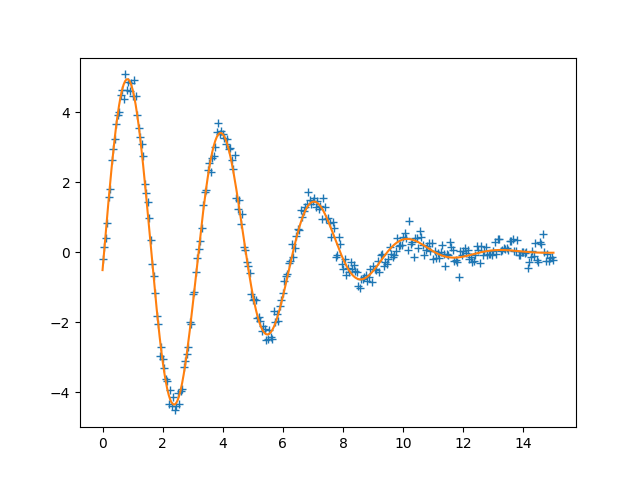Note
Go to the end to download the full example code.
Parameters - valuesdict¶

[[Fit Statistics]]
# fitting method = leastsq
# function evals = 64
# data points = 301
# variables = 4
chi-square = 12.1867036
reduced chi-square = 0.04103267
Akaike info crit = -957.236198
Bayesian info crit = -942.407756
[[Variables]]
amp: 5.03088059 +/- 0.04005824 (0.80%) (init = 10)
decay: 0.02495457 +/- 4.5396e-04 (1.82%) (init = 0.1)
omega: 2.00026310 +/- 0.00326183 (0.16%) (init = 3)
shift: -0.10264952 +/- 0.01022294 (9.96%) (init = 0)
[[Correlations]] (unreported correlations are < 0.100)
C(omega, shift) = -0.7852
C(amp, decay) = +0.5840
C(amp, shift) = -0.1179
# <examples/doc_parameters_valuesdict.py>
import numpy as np
from lmfit import Minimizer, create_params, report_fit
# create data to be fitted
x = np.linspace(0, 15, 301)
np.random.seed(2021)
data = (5.0 * np.sin(2.0*x - 0.1) * np.exp(-x*x*0.025) +
np.random.normal(size=x.size, scale=0.2))
# define objective function: returns the array to be minimized
def fcn2min(params, x, data):
"""Model a decaying sine wave and subtract data."""
v = params.valuesdict()
model = v['amp'] * np.sin(x * v['omega'] + v['shift']) * np.exp(-x*x*v['decay'])
return model - data
# create a set of Parameters
params = create_params(amp=dict(value=10, min=0),
decay=0.1,
omega=3.0,
shift=dict(value=0.0, min=-np.pi/2., max=np.pi/2))
# do fit, here with the default leastsq algorithm
minner = Minimizer(fcn2min, params, fcn_args=(x, data))
result = minner.minimize()
# calculate final result
final = data + result.residual
# write error report
report_fit(result)
# try to plot results
try:
import matplotlib.pyplot as plt
plt.plot(x, data, '+')
plt.plot(x, final)
plt.show()
except ImportError:
pass
# <end of examples/doc_parameters_valuesdict.py>
Total running time of the script: (0 minutes 0.282 seconds)
